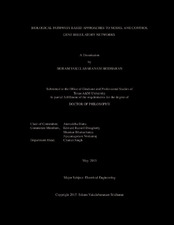| dc.description.abstract | The aim of effective cancer treatment is to prolong the patients’ life while offering a reasonable quality of life during and after treatment. The treatments must carry their actions/effects in a manner such that a very large percentage of tumor cells die or shift into a state where they stop proliferating. The fundamental issue in systems biology is to model gene interaction via gene regulatory networks (GRN) and hence provide an informatics environment to study the effects of gene mutation as well as derive newer and effective intervention (via drugs) strategies to alter the cancerous state of the network, thereby eradicating the tumor. In this dissertation, we present two approaches to model gene regulatory networks. These approach are different, albeit having a common structure to them.
We develop the GRN under a Boolean formalism with deterministic and stochastic framework. The knowledge used to model these networks are derived from biological pathways, which are partial and incomplete. This work is an attempt towards understanding the dynamics of a proliferating cell and to control this system. Initial part (deterministic) of this work focuses on formulating a deterministic model by assuming the pathway regulations to be complete and accurate. Using these models algorithms were developed to pin-point faults (mutations) in the network and design personalized combination therapy depending on the expression signature of specific output genes.
To introduce stochastic nature onto the model due to incompleteness in the prior biological knowledge, an uncertainty class of models was defined over the biological network. Two such uncertainty class of models are modeled- one over the state transitions and the other over the node transitions in the system. This knowledge is transferred to priors, and the existing Bayesian theory is used to update and converge to a good model. The Bayesian control theory for Markovian processes is applied to the problem of intervention in Markovian gene regulatory networks, while simultaneously updating the model. Via a toy example, it is shown that effective prior knowledge quantification can significantly help in converging on to the actual model with limited information from the system and take advantage of the optimality promised by Bayesian intervention. These control methods however, suffer from computational and memory complexity issues- Curse of Dimensionality, to be useful for any network size of biological relevance. To counter these issues associated with Dynamic Programming, suboptimal approximate algorithm known as Q-learning and its Bayesian variation are used to save on computational and memory complexities. These sub-optimal approximate algorithms perform very close (but inferior) to optimal policy, but the computational saving, both in terms of time and memory are significant to extend them to networks of larger size. | en |


